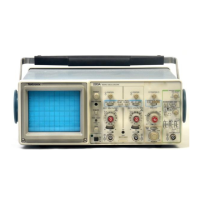Section 2—2213A Operators
PREPARATION FOR USE
FIRST-TIME START UP
SAFETY
Refer to the “Operators Safety Summary” at the front of
this manual for power source, grounding, and other safety
considerations pertaining to the use of the 2213A. Before
connecting the instrument to a power source, carefully read
the following about line voltages, power cords, and fuses.
LINE VOLTAGE
The instrument is capable of continuous operation using
input voltages that range from 90 V to 250 V nominal at
frequencies from 48 Hz to 440 Hz.
POWER CORD
A detachable three-wire power cord with a three-contact
plug is provided with each instrument to permit connection
to both the power source and protective ground. The plug
protective-ground contact connects (through the protective-
ground conductoi)to the accessible metal parts of the instru
ment. For electrical-shock protection, insert this plug only
into a power outlet that has a securely grounded protective-
ground contact.
This instrument is shipped with the required power cord
as ordered by the customer. Available power-cord informa
tion is illustrated in Figure 2-1, and part numbers are listed in
Section 5 of this manual Tkxitact your Tektronix represen
tative or local Tektronix Field Office for additional power-
cord information.
LINE FUSE
The instrument fuse holder is located on the rear panel
(see Figure 2-2) and contains the line fuse. The following
procedure can be used to verify that the proper fuse is in
stalled or to install a replacement fuse.
1. Unplug the power cord from the power-input source
(if applicable).
Plug
Configuration
Usage
Line
Voltage
Reference
Standards
North
American
1 2 0 V /
15A
120V
ANSI C73.11
NEMA 5-15-P
IEC 83
Universal
Euro
2 4 0 V /
10-16A
240V
CEE |7).11,1V,VII
IEC 83
UK
2 4 0 V /
13A
240V
BS 1363
IEC 83
Australian
2 4 0 V /
10A
240V
AS C112
North
American
2 4 0 V /
15A
240V
ANSI C73.20
NEMA 6-15-P
IEC 83
Switzerland
2 2 0 V /
10A
220V SEV
Abbreviations:
AN SI - American National Standards Institute
AS — Standards Association o f Australia
BS — British Standards Institution
CEE — International Commission on Rules fo r the
Approval of Electrical Equipment
IEC — International Electrotechnical Commission
NEM A — National Electrical M anufacturer's Association
SEV — Schweizevischer Elektrotechischer Verein C4732-02
Figure 2-1. Optional power cords.
2. Press in and slightly rotate the fuse-holder cap coun
terclockwise to release it.
3. Pull the cap (with the attached fuse inside) out of the
fuse holder.
4. Verify proper fuse value (1.0 A, 250 V, slow blow).
5. Reinstall the fuse (or replacement fuse) and the fuse-
holder cap.
REV APR 1985
2-1

